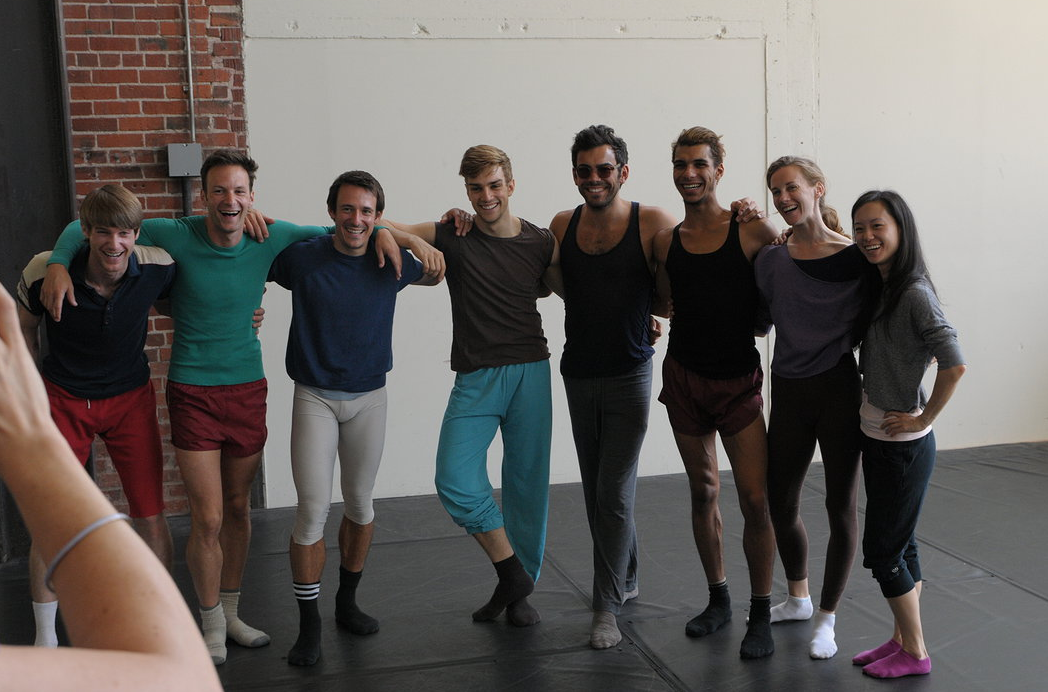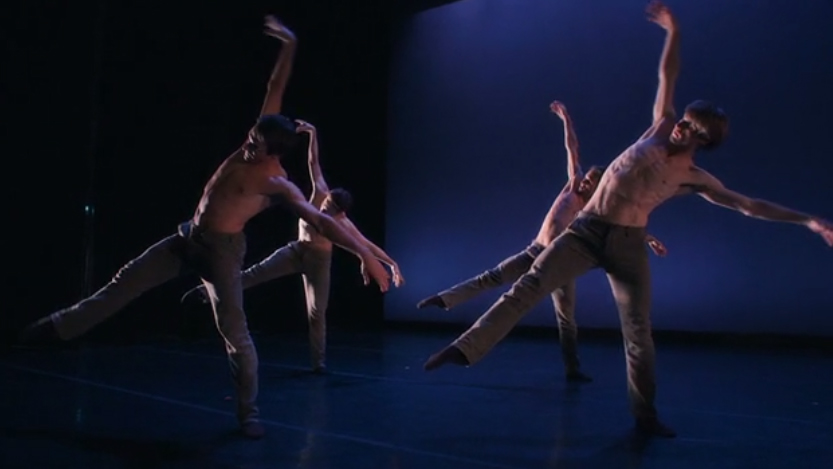One of this year's best indies Test is about a young understudy dancer in San Francisco. Though it's only made a teensy bit of money in a microscopic theatrical run (that's happening to more and more indies) at one point it climbed to the top 15 on iTunes' indie chart.
 TEST's dance troupe at rehearsal
TEST's dance troupe at rehearsal
It's a topic for another time perhaps but I wonder how far we are away from box office reports that include money from On Demand and iTunes now that so many films hit all three venues at once or in quick succession?
The following are unused excerpts (edited for length) from my Towleroad interview last week with Chris Mason Johnson the director. I thought they were well suited to you cinephile savvy musical-friendly nuts anyway. It's rare that we get such attentively filmed and beautiful dancing onscreen so I had to ask him about the camerawork and how his history as a dancer played into the movie.
 Chris Mason Johnson with his prizes from "OutFest"Nathaniel: Test is your second movie and it feels confident.
Chris Mason Johnson with his prizes from "OutFest"Nathaniel: Test is your second movie and it feels confident.
CHRIS MASON JOHNSON: Well after The New Twenty (2008) -- making movies is a combination of a hugely difficult set of skills. In the old days all the famous directors we know from the classic era, they apprenticed forever. I think Robert Altman did 11 TV movies before his first feature. In our culture it's this crazy kind of 'come out of the door fully formed and go to Sundance' mythology. It's bullshit. TV is the new Hollywood in a way - people can learn their craft there.
Why the long break between your two movies?
I tried to get something much more commercial off the ground. It was the classic story of waiting on money. Almost getting going, etcetera. It was such a demoralizing experience because you have no power. At a certain point I said 'Screw it. I know how to make movies and I'm going to do something small and personal.'
Dance gives the familiar backdrop [the AIDS crisis in the 80s] such a fresh angle.
It's just as much about dance as it is about anything else. In terms of the dance, I did a fun thing with the dance climax scene where the understudy goes on. That's been the über dance narrative from 42nd street through The Red Shoes through The Turning Point through Black Swan. That's always the story and I wanted to do that again but I wanted to do it how I'd experienced it. I'd gone on multiple times, one time with Barysynikov, one time in New York and you prove yourself and it's amazing. And then you go back to work the next day, the person gets better, and you're watching it again.
It's very different than the Broadway version where you become a star. So I put the dance in the middle of the movie. That's always the climax of those movies but I put it smack in the middle which is a different kind of structure.
As an aficionado of musicals, I have to tell you that it was hugely refreshing to see a complete dance number that didn't cut every second to a new angle or stay with closeups. That makes me so crazy. You pulled the camera back. Thank you!
It makes me crazy, too. In terms of the overall style we wanted to hit this perfect balance where real dancers would like it and it was real dancing but also just fun for an audience. We knew we wanted to do really exciting contemporary dance. In terms of framing there's this happy medium where you frame the full body and you respect the space but you also cut enough and move the camera enough for dynamics. Otherwise it would be inert. Pina did a genius job of that. I loved that.
For me the moving camera is like a moving body is in choreography so I love playing with that.

The cinematography is beautiful which surprised me. That's a craft that's hit & miss with indies.
This was $200,000 [budget]. In some sense people really only understand indies on that microbudget level if they look microbudget: down and dirty and gritty. Everyone gets that mode. When you get something that looks really polished and cinematic, it's harder for people to make sense of it on a microbudget. My cinematographer's name is Daniel Marks. It's his first feature out of AFI but I've known him for ten years. He's just super talented. The script was not dialogue based so we planned it as images. I really love an image based cinema and that's not the dominant strain in America. I'm really happy with the way it looks.
Even though you've said you'd like to move toward TV, I hope you're planning to continue with dance. TV needs more dance that's not reality show competitions.
The question is did Smash ruin the theater for network? From the powers that be point of view 'Oh we tried it, it didn't work!'

Have you seen Test yet, readers? Do you love the trope of the understudy who goes on?